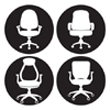What
are important things to look for in buying an office chair,
especially when you are going to be sitting at your desk for a long
time, looking at a monitor and doing transcription?
 Face it, you may sit at work for at least a third of your
day. You owe it to yourself to be comfortable there. What
features are critical in selection of the right chair for
you? It is important to select an office chair with the
proper fit for your body type and work demands. It is even
more important to avoid prolonged sitting, and to move
around frequently to reduce postural strain that may lead to
musculoskeletal injuries, pain and disability. Get up at
least every half-hour to move and stretch gently. Move your
hands if you type for prolonged periods of time. Choose a
chair that is individually adjustable for seat height,
backrest height and angle, lumbar support, armrest height
and width, and tilt. Do sit in the chair for at least an
hour to try it. Better yet, ask for a one week trial before
you purchase. Many companies will allow a trial period. You
never know until you used it all day! It will cost you more
in medical copayments and lost wages to sit in a poorly
fitted chair that to buy one that suits you just right. The
right ergonomic position has your spine fully supported with
your head level, neck upright, with its normal inward curve,
shoulders relaxed in alignment with your ears. Your elbows
are bent ninety degrees, at the height of your work surface,
with forearms resting on the armrests to relax your
shoulders. Wrists are straight. A wrist rest is helpful to
reduce pressure on sensitive forearm nerves. Remember, the
work surface height should allow for your arms to be at the
level of your desk. Your thighs are parallel to the floor,
knees are ninety degrees, and with feet flat on the floor. A
computer monitor should be positioned 18-24 inches away from
your face, just below eye level. Be sure you are wearing
proper eyeglasses if you cannot see the monitor well.
Face it, you may sit at work for at least a third of your
day. You owe it to yourself to be comfortable there. What
features are critical in selection of the right chair for
you? It is important to select an office chair with the
proper fit for your body type and work demands. It is even
more important to avoid prolonged sitting, and to move
around frequently to reduce postural strain that may lead to
musculoskeletal injuries, pain and disability. Get up at
least every half-hour to move and stretch gently. Move your
hands if you type for prolonged periods of time. Choose a
chair that is individually adjustable for seat height,
backrest height and angle, lumbar support, armrest height
and width, and tilt. Do sit in the chair for at least an
hour to try it. Better yet, ask for a one week trial before
you purchase. Many companies will allow a trial period. You
never know until you used it all day! It will cost you more
in medical copayments and lost wages to sit in a poorly
fitted chair that to buy one that suits you just right. The
right ergonomic position has your spine fully supported with
your head level, neck upright, with its normal inward curve,
shoulders relaxed in alignment with your ears. Your elbows
are bent ninety degrees, at the height of your work surface,
with forearms resting on the armrests to relax your
shoulders. Wrists are straight. A wrist rest is helpful to
reduce pressure on sensitive forearm nerves. Remember, the
work surface height should allow for your arms to be at the
level of your desk. Your thighs are parallel to the floor,
knees are ninety degrees, and with feet flat on the floor. A
computer monitor should be positioned 18-24 inches away from
your face, just below eye level. Be sure you are wearing
proper eyeglasses if you cannot see the monitor well.
1. The seat height should adjust between a range of 15-22
inches for an adult between 60-76 inches tall. A pneumatic
lift allows you to alter the height while seated. Check that
the seat is at least an inch wider than your hips, with the
edge (seatpan) at least 2 inches behind your knees. The seat
pad should not compress after sitting for an hour. If it
does, it is poor quality foam and you may develop
discomfort. Seat depth adjustability helps provide better
back support and keep you from sliding forward or backward
in your chair.
2. The seat angle should be adjustable. Raising the front of
the seat slightly allows your knees to be just higher than
your hips, providing better lumbar-pelvic support.
3. The backrest must support your entire back, not just
cover the lower back. It should have an adjustable inward
curve, “lumbar roll” support that fits snugly into the
natural curve (lordosis) of your lower back to provide
optimal support and avoid fatigue. Backrest width should be
between 12-19 inches wide. Reclining backrests provide the
opportunity to relieve the pressure of prolonged sitting.
Look for a recline adjustment to allow for reclining 110-130
degrees.
4. Chair bases should have five spokes for stability.
Casters must move freely and not jam.
5. A footrest may be necessary if your feet do not touch the
floor with the ankles at a 90 degree angle: feet flat.
6. Seat material is typically either fabric or vinyl. Fabric
allows better breathability but is more difficult to clean
than vinyl.
What should you look for in a desk chair that is under
$200.00?
Look for the maximal adjustability in an economical chair.
You need a minimum of seat height and backrest adjustments.
You can always add a lumbar pillow and seat pad for extra
support later. Avoid being too thrifty; it may cost you
later to suffer from the lack of proper support. If you
cannot afford a better chair, make up for it by keeping in
great physical shape with plenty of exercise and move around
frequently while working for the best result.
Dr. Schmidt is a board-certified specialist in orthopedic
physical therapy and a certified ergonomic assessment
specialist. Learn more with free videos, home study and live
seminars with Educise at
www.educise.com. And on Facebook at
www.facebook.com/educiseresourcesinc.



 Face it, you may sit at work for at least a third of your
day. You owe it to yourself to be comfortable there. What
features are critical in selection of the right chair for
you? It is important to select an office chair with the
proper fit for your body type and work demands. It is even
more important to avoid prolonged sitting, and to move
around frequently to reduce postural strain that may lead to
musculoskeletal injuries, pain and disability. Get up at
least every half-hour to move and stretch gently. Move your
hands if you type for prolonged periods of time. Choose a
chair that is individually adjustable for seat height,
backrest height and angle, lumbar support, armrest height
and width, and tilt. Do sit in the chair for at least an
hour to try it. Better yet, ask for a one week trial before
you purchase. Many companies will allow a trial period. You
never know until you used it all day! It will cost you more
in medical copayments and lost wages to sit in a poorly
fitted chair that to buy one that suits you just right. The
right ergonomic position has your spine fully supported with
your head level, neck upright, with its normal inward curve,
shoulders relaxed in alignment with your ears. Your elbows
are bent ninety degrees, at the height of your work surface,
with forearms resting on the armrests to relax your
shoulders. Wrists are straight. A wrist rest is helpful to
reduce pressure on sensitive forearm nerves. Remember, the
work surface height should allow for your arms to be at the
level of your desk. Your thighs are parallel to the floor,
knees are ninety degrees, and with feet flat on the floor. A
computer monitor should be positioned 18-24 inches away from
your face, just below eye level. Be sure you are wearing
proper eyeglasses if you cannot see the monitor well.
Face it, you may sit at work for at least a third of your
day. You owe it to yourself to be comfortable there. What
features are critical in selection of the right chair for
you? It is important to select an office chair with the
proper fit for your body type and work demands. It is even
more important to avoid prolonged sitting, and to move
around frequently to reduce postural strain that may lead to
musculoskeletal injuries, pain and disability. Get up at
least every half-hour to move and stretch gently. Move your
hands if you type for prolonged periods of time. Choose a
chair that is individually adjustable for seat height,
backrest height and angle, lumbar support, armrest height
and width, and tilt. Do sit in the chair for at least an
hour to try it. Better yet, ask for a one week trial before
you purchase. Many companies will allow a trial period. You
never know until you used it all day! It will cost you more
in medical copayments and lost wages to sit in a poorly
fitted chair that to buy one that suits you just right. The
right ergonomic position has your spine fully supported with
your head level, neck upright, with its normal inward curve,
shoulders relaxed in alignment with your ears. Your elbows
are bent ninety degrees, at the height of your work surface,
with forearms resting on the armrests to relax your
shoulders. Wrists are straight. A wrist rest is helpful to
reduce pressure on sensitive forearm nerves. Remember, the
work surface height should allow for your arms to be at the
level of your desk. Your thighs are parallel to the floor,
knees are ninety degrees, and with feet flat on the floor. A
computer monitor should be positioned 18-24 inches away from
your face, just below eye level. Be sure you are wearing
proper eyeglasses if you cannot see the monitor well.




